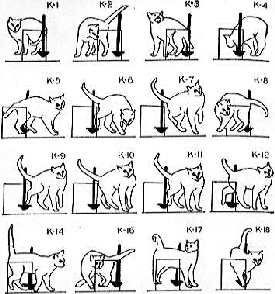Theory
Law of
Contiguity:
Guthrie's
law of contiguity states that a combination of stimuli which has accompanied
a movement will on its recurrence tend to be followed by that movement
(Guthrie, 1952). He said that all learning is based on a stimulus-response
association. Movements are small stimulus- response combinations. These
movements make up an act. A learned behavior is a series of movements. It
takes time for the movements to develop into an act. He believed that
learning is incremental. Some behavior involves repetition of movements and
what is learned are movements, not behaviors (Internet, 1999).
Guthrie
stated that each movement produces stimuli and the stimuli then become
conditioned. Every motion serves as a stimulus to many sense organs in
muscles, tendons and joints. Stimuli which are acting at the time of a
response become conditioners of that response. Movement-produced stimuli
have become conditioners of the succession of movements. The movements form
a series often referred to as a habit. Our movements are often classified as
forms of conditioning or association. Some behavior involves the repetition
of movements, so that conditioning can occur long after the original
stimulus.
Guthrie
rejected the law of frequency. He believed in one-trial learning. One-trial
learning states that a stimulus pattern gains its full associative strength
on the occasion of its first pairing with a response. He did not believe
that learning is dependent on reinforcement. He defined reinforcement as
anything that alters the stimulus situation for the learner (Thorne and
Henley, 1997). He rejected reinforcement because it occurs after the
association between the stimulus and the response has occurred. He believed
that learning is the process of establishing new stimuli as cues for some
specified response (Sills, 1968).
Guthrie
believed that the recency principle plays an integral role in the learning
process. This principle states that which was done last in the presence of a
set of stimuli will be that which is done when the stimulus combination
occurs again. He believed that it is the time relation between the
substitute stimulus and the response that count. Associative strength is
greater when the association is novel. When two associations are present
with the same cue, the more recent will prevail. The stimulus-response
connections tend to grow weaker with elapsed time.
Contiguity
theory implies that forgetting is a form of retroactive or associative
inhibition. Associative inhibition occurs when one habit prevents another
due to some stronger stimuli. Guthrie stated that forgetting is due to
interference because the stimuli become associated with new responses
(Internet, 1999). He believed that you can use sidetracking to change
previous conditioning. This involves discovering the initial cues for the
habit and associating other behavior with those cues. Sidetracking causes
the internal associations to break up. It is easier to sidetrack than to
break a habit. Other methods used to break habits include threshold,
fatigue, and the incompatible response method. Fatigue is a change in
behavior-altered chemical states in the muscle and blood stream. It has the
effect of decreasing the conditioned response. The stimulus conditions the
other responses thus inhibiting the response. The threshold method involves
presenting cues at such low levels that the response does not occur. The
stimulus is then increased thus raising the response threshold. The
incompatible stimulus method involves presenting the stimulus for the
behavior we want to remove when other aspects of the situation will prevent
the response from occurring (Thorne and Henley, 1997). Excitement
facilitates learning and also the stereotyping of a habit. It is the
conflict responsible for the excitement that breaks up the old habit.
Breaking up a habit involves finding the cues that initiate the action and
practicing another response to such cues.
 Experiment:
Experiment:
Guthrie did
a collaborative study with George P. Horton which involved the stereotyped
behavior of cats in the puzzle box. Horton set up the trials and supervised
the photography, while Guthrie took notes in shorthand. The Guthrie-Horton
experiment illustrated the associative theory of learning. They used a glass
paneled box which allowed them to photograph the cats' movements. The box
was constructed so that the cat could open the door by touching a post. It
took approximately 15 minutes for the cat to touch the post. The second
time, the cat had the tendency to duplicate its first behavior. The
photographs showed that the cats repeated the same sequence of movements
associated with their previous escape from the box. This showed an example
of stereotyped behavior. The Guthrie-Horton experiment allows us to assume
than an animal learns an association between a stimulus and a behavioral act
after only one experience. Guthrie stated that numerous trials are not
duplications, but learning to respond to similar stimulus complexes. Only
after we form several associations can the behavioral criterion of learning
be achieved (Wolman, 1973).
Education:
Guthrie used
the contiguity theory while teaching at the University of Washington.
"We learn only what we ourselves do" (Sills, 1968). The responses
we wish to cue to various stimuli must be made by the individual himself in
the presence of those stimuli (Sills, 1968). He extends this philosophy when
emphasizing that circumstances must be changed in order to further learning.
Teachers often limit their involvement in the classroom in order to further
student learning. By doing this, they allow the student to make the desired
responses without stimuli from the teacher. Guthrie had a large interest in
the evaluation of teaching ability. He stressed the idea that the
circumstances under which he wishes the desired response to be made in the
future should be approximated as closely as possible by the present
circumstances (Sills, 1968).
Although
Guthrie's theory of contiguity has been criticized for its simplicity, it
remains popular to many psychologists due to its use of simple terms in
illustrating complex ideas.